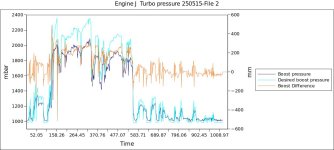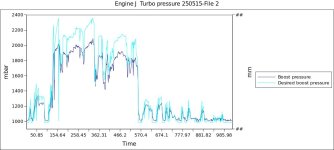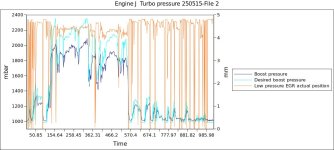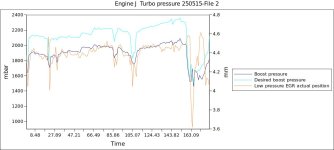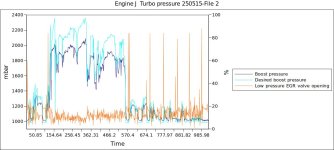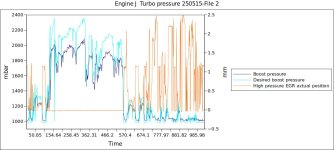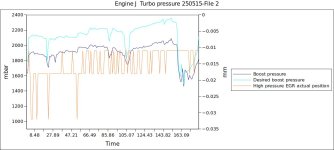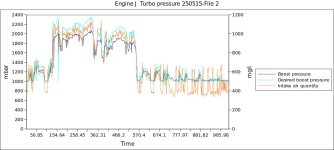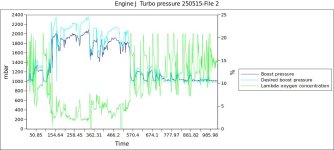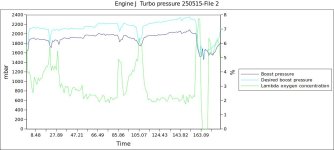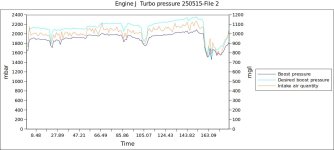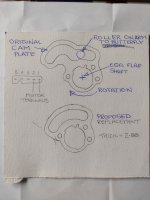@theoneandonly v32 upgrade was done lately, (last year or just before) and from the beginning I was on tuned version. The first time when problem came was after driving during several years (5) on tuned but old software. Then upgrade to v32 but no effect, besides that last summer I've done 5000km with no faults but in September problems came back. Attaching csv from todays ride, hope I've chosen right settings proposed by
@deejays Today second part (half way), going back home was against rather strong wind blowing about 55km/h (today and yesterday no faults)
@jansla , thank you for confirming your engine is (or was!) 130HP. The reason I knew that was because two parameters (Turbo Control Position, desired and actual) are showing null result.
The 130HP has a wastegate and not a VGT/VVT as fitted to the 150HP and 180HP versions. The VGT/VVT turbo has positional feedback whereas the wastegate version does not.
The upside is you have two more
MES parameter slots you can put to good use instead; the downside is you have no idea if the turbo is following the requested commands of the Turbo Solenoid.
Some 40 to 50 years ago I spent many hundreds of hours modifying Lotus Twin Cam engines to develop considerably more power for racing purposes. But there is no way I would even consider modifying the programming of any of the software in any vehicle – particularly this engine. Both Magneti Marelli and FIAT have vast resources and talent and many years of development experience to deliver this vehicle. To then think that some relatively tin-pot company knows better, I believe is a folly. If more power and torque was the name of the game, why not buy the higher-powered version in the first place? That said, this issue may have happened regardless – so don’t feel too bad about it.
Understanding that the ECU was modified early on, over the original SW V24, then having the ECU updated to V32, can one be sure what the current state of programming the ECU is I wonder?
Having said all that that, let’s move on and have a look at the data.
Fuel Quantity, Air Quantity, HPEGR and LPEGR all seem to line up as to Actual Position achieving the Desired/Target position, so those actuators at least can be confirmed to be following the directions of the ECU commands. I won’t display the graphs here – I encourage you to have a look yourself to confirm.
The Atmospheric Pressure and MAF Air Temperature would also appear to be reporting correctly, although you can confirm that precisely yourself.
The Boost Pressure is an issue across the Time, Pressure, RPM, and Speed Domain. Following are two graphs showing first, Time domain, then Pressure domain. RPM and Speed range require active toggling to view so are not shown here, but you can do so yourself if you want to view it. The boost pressure is down some 10% to 12% of where it should be (but again, what program is it responding to?).
Time Domain:
Pressure Domain:
The question of course is, what is causing this discrepancy? It could be a failing turbo, it could also be a near blocked LPEGR cooler, it also could be made worse by a congested intercooler. Understanding the turbo vacuum solenoid and associated components as well as the MAP sensor have been checked and or replaced and confirmed to be working correctly then those components will not be part of this consideration.
Let’s move onto the elephant in the room, shall we?
The LPEGR valve is rarely observed to be modulating linearly and when it does, it is at the high (open) end of its range. Coincident with this, the recorded LPEGR Temperature is high and judging by the “reference” of my engine data, the MAP Air Temperature should be in the range of 50C to 70C but instead is hovering much lower at approximately 30C. If the LPEGR valve is wide open for most of the time with a high LPEGR Gas temperature, then why is the MAP Temperature so low? One explanation is that the LPEGR cooler is significantly blocked, but not totally, thus allowing some high temperature gas to flow, but not enough to raise the MAP temperature. (But this is not the same engine as the “reference” and has had modifications applied to the ECU). The MAP temperature sensor can be confirmed as working correctly because it can be observed that when the HPEGR valve opens it causes the MAP Temperature to rise to the expected temperature range. So, perhaps a blocking LPEGR cooler then? Or perhaps a failing turbo? Or both? Or something else?
If the fault is intermittent, then it may pay dividends to have a close read of the following link as it describes an interesting and similar issue for the same 130HP engine:
(But it does not make any reference to the implicated low temperature of the Inlet Manifold).
https://www.picoauto.com/library/ca...th-turbo-under-boost-and-air-flow-meter-drift
If this was my engine and my wallet, before I handed over any more money for any more parts I would want to visually confirm the condition of the internal health of the LPEGR cooler, the intercooler, and a full check of the relevant wiring as per the above link and perhaps even a test as per the link.
One thing to keep in mind. For some years you have had an exhaust pipe with significant black soot. You cannot find even one speck inside the exhaust pipe of my vehicle. If there is soot in this engine exhaust pipe, then the DPF has failed. Eventually the LPEGR cooler will block as a result. This is documented throughout this brilliant thread created by
@Fredastaire .
This is an excellent opportunity for anyone reading this who owns a healthy 130HP engine to perhaps offer a sample CSV file with the parameters that are being measured in this case.


